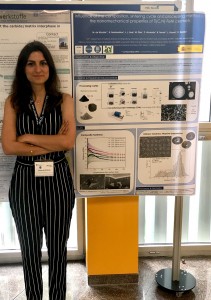![]()
Influence of the composition, sintering cycle and processing method in the nanomechanical properties of Ti(C,N)-feni cermets
El pasado 27-29 de junio de 2018 se celebró el Workshop on Micromechanical properties of Hard Materials en la Universitat Politècnica de Catalunya. María de Nicolás, miembro del GTP(UC3M) participó con el poster «Influence of the composition, sintering cycle and processing method in the nanomechanical properties of Ti(C,N)-feni cermets»

1 Department of Materials Science and Engineering, University Carlos III of Madrid, Avda. Universidad, 30, 28911 Leganés, Madrid, Spain *mnicolas@ing.uc3m.es
2 Escola d’Enginyeria de Barcelona Est (EEBE), Universitat Politècnica de Catalunya. Campus Diagonal Besòs, Eduard Maristany, 10-14, 08019 Barcelona
3 Institute of Ceramic and Glass, CSIC, Kelsen, 5, 28049 Madrid, Spain
Keywords: Cermets, FeNi, liquid phase sintering, nanoindentation, nanoscratch
Abstract: Influence of the composition, sintering cycle and processing method in the nanomechanical properties of ti(c,n)-feni cermets[/caption] The fluctuating price and toxicity of Co and the classification of cemented carbides (WC-Co) as hazardous materials for human health are encouraging the investigation of alternative materials. In this work, a Ti(C,N)-based cermet with an iron alloy (Fe-15 wt% Ni) as metal matrix has been processed. Two different processing routes were employed: colloidal and conventional powder metallurgy, corresponding to low-energy ball milling. Several parameters were varied in the manufactured materials for study: (i) ceramic-metal volumetric ratio (70/30, 80/20 and 85/15); (ii) carbon addition, from 0 to 1 wt. % with respect to the metal matrix, to learn the effect of this element on the material; (iii) sintering cycle, maintaining the same sintering temperature and time (1450 °C, 2 h) and adding an additional step of 30 min at 1000 °C. Regarding the conventional route, two pressing methods were used for the first sintering cycle: uniaxial and cold isostatic pressing (CIP). The final sintered materials were characterized in terms of their hardness and elastic modulus. Nanoindentation tests were performed on the composite materials and their constituent phases, ceramic reinforcement and metal matrix, following Ulm and Constantinides statistical analysis. AFM (Atomic Force Microscopy) and FIB (Focused Ion Beam) were used to evaluate the plastic deformation mechanisms of the material. Moreover, cross-section nanoscratches were performed at the ceramic-metal contact areas to evaluate the sliding contact at the interface.

Enhorabuena por la investigación. Información muy interesante.